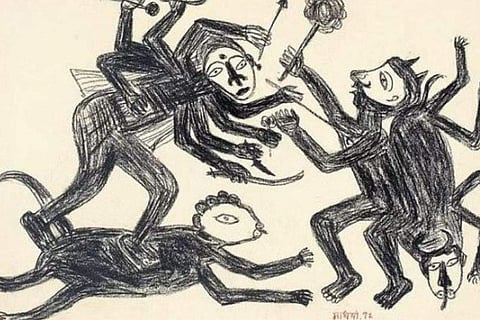
- LIFESTYLE
- FASHION
- FOOD
- ENTERTAINMENT
- EVENTS
- CULTURE
- VIDEOS
- WEB STORIES
- GALLERIES
- GADGETS
- CAR & BIKE
- SOCIETY
- TRAVEL
- NORTH EAST
- INDULGE CONNECT

Born a year apart in different parts of the country Madhvi Parekh in Sanjaya village, Gujarat, in 1942, and Shobha Broota in Delhi in 1943—they are India’s top women artists whose advancing years haven’t inhibited their constant state of discovery. But, the similarity ends there. Separated by pin codes, their artworks couldn’t be more different.
Parekh’s five canvases on display at Agradoot: Agents of Change, curated by art historian Alka Pande at Art Alive Gallery, depict the folk and Shakti imagery she is known for. Broota has stayed true to her geometric abstractionism, working with wool and thread for her four pieces in the show. Parekh delves deep into the Gujarati embroidery styles, while her contemporary work speaks through intertwined threads of the chaos and beauty that gives her city its character. Their colour schemes are polar opposites. Broota uses bold hues—purple and blue being prominent—Parekh has a subdued palette: there are two monochromatic charcoal pieces. Both have held numerous exhibitions across the world, but this is the first time their works appear together. The show is a tour de force through the creative imaginations of 11 women artists, and the role they play in society.
Now at 82, Parekh has never been busier. As she prepares to hold a retrospective in her Delhi home, she has taken a detour into the world of fashion. Hand-embroidered tapestries of her early works—one was made when she was pregnant with her first child in 1968—were backdrops for the Dior fashion show at the Musée Rodin in Paris in 2022. The works later travelled to Mumbai for the brand’s first show in India this year. “It was a unique collaboration. I was impressed by the way they interpreted my favourite shade of green with embroidery,” says the artist, who was paid `25 for her first sale in Kolkata.
" I didn’t know what to do with it. I didn’t even have a bank account,” says Parekh, who draws inspiration from the likes of Swiss-German artist Paul Klee and Catalan painter and sculptor Joan Miro. Married to the equally famous Manu Parekh, she was a country bride with no idea of the world of art that awaited her. Manu encouraged her and gifted her a book on drawing exercises by Paul Klee: while not derivative, the dots, lines, circles and triangles repeated in her work are Klee-like. Parekh’s characters are often products of her imagination; figurative and abstract with a wealth of repetitive detail. Kalamkari and Pichwai styles are regular leitmotifs with the central character placed in the middle of a crowd of a supporting cast filling the borders.
Unlike Parekh’s commitment to constancy, Broota kept evolving. She is a sangeet visharad who became an abstractionist after starting her career as a figurative artist. Her studio in Soami Nagar, Delhi, is stocked with old oil portraits; former South Korean president Park Chung-hee and a self-portrait hides under later paintings in which the ‘centre’ hypnotises the viewer. “I started branching into abstraction by letting go of one element after another, until only the centre was left.
The more I travelled the world, my views changed and works became abstractionist,” says the 80-year-old, who taught at Triveni Kala Sangam and continues to teach art students at her studio. Like all artists, both ladies of colours have experimented with mediums such as acrylic, water and oil. “There was a time when I would do only monochromes. Colour then seemed distant. Even today, I prefer working with lines. I find it therapeutic,” admits Parekh. So does Broota; an unexpected similarity at last.
“Every day, I dedicate a certain amount of time only to my knitting,” she says, adding while she is very comfortable with oil, acrylic is a no no. Does she still paint every day? “Of course. My art is like breathing,” says Broota, as she returns to knitting, with strains of Ustad Vilayat Khan’s sitar playing in the background. Parekh, too, regrets any day when she’s unable to paint due to household chores. She says, “I feel incomplete,” as she thumbs through an old magazine, which displays a painting of hers on its cover. “While making this, I wanted to draw a hibiscus, which I couldn’t. So I turned it into a bird.” For the two doyens of Indian art, despite their dissimilarities of backgrounds and styles, the common bond that never stops blooming is their search for fresh imagery and innovation, sweaters and socks notwithstanding.